 Slide 1. Rolling Plains agriculture has the highest risk and lowest profit margin of any agricultural production area in our state.
Slide 1. Rolling Plains agriculture has the highest risk and lowest profit margin of any agricultural production area in our state.
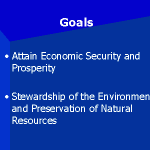 Slide 2. The crop-oriented research and extension programs headquartered at Vernon are primarily directed at achieving success of the statewide Ag Program goals of 1. attaining economic security and economic prosperity for Rolling Plains producers and 2. Environmental stewardship and preserving natural resources.
Slide 2. The crop-oriented research and extension programs headquartered at Vernon are primarily directed at achieving success of the statewide Ag Program goals of 1. attaining economic security and economic prosperity for Rolling Plains producers and 2. Environmental stewardship and preserving natural resources.
 Slide 3. We believe these goals can be achieved by decreasing the unit cost of production, increasing the amount of production per unit and by exploring ways to maximize the value of the products produced. We have spent years developing discipline-specific data bases. We now need to develop new multidisciplinary programs.
Slide 3. We believe these goals can be achieved by decreasing the unit cost of production, increasing the amount of production per unit and by exploring ways to maximize the value of the products produced. We have spent years developing discipline-specific data bases. We now need to develop new multidisciplinary programs.
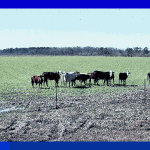 Slide 4. Our vision is the development of integrated crop management technologies which can be fully integrated with range and pasture production systems to achieve an agriculture which is both profitable and sustainable. To capitalize on the opportunities of the future, it is essential to evaluate the current condition of Rolling Plains agriculture.
Slide 4. Our vision is the development of integrated crop management technologies which can be fully integrated with range and pasture production systems to achieve an agriculture which is both profitable and sustainable. To capitalize on the opportunities of the future, it is essential to evaluate the current condition of Rolling Plains agriculture.
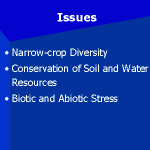 Slide 5. We are challenged by a lack of crop diversity, by the need to conserve soil and water resources and by the biotic and abiotic stresses which annually limit our production potential. Each of these complex issues is being addressed by scientists at Texas AgriLife Research and Extension Center at Vernon.
Slide 5. We are challenged by a lack of crop diversity, by the need to conserve soil and water resources and by the biotic and abiotic stresses which annually limit our production potential. Each of these complex issues is being addressed by scientists at Texas AgriLife Research and Extension Center at Vernon.
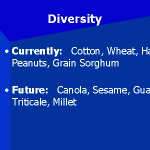 Slide 6. Crop diversity in the Rolling Plains is narrow and currently includes cotton and wheat with relatively small acreages of hay, peanuts and grain sorghum. New research focuses on the preservation of these major commodities but with added emphasis on the identification of novel alternatives.
Slide 6. Crop diversity in the Rolling Plains is narrow and currently includes cotton and wheat with relatively small acreages of hay, peanuts and grain sorghum. New research focuses on the preservation of these major commodities but with added emphasis on the identification of novel alternatives.
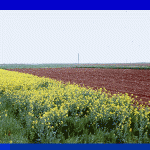 Slide 7. Canola, an excellent source of high-quality edible oil, has been a part of the research effort at Vernon for the past 7 years. A portion of the canola research is currently conducted as a joint project with other Land Grant Universities in the southern Great Plains who share a common goal of crop diversification. We have not yet found varieties of canola which adequately resist the rigors of our environment but we feel confident that this will happen. Sesame is adapted to semiarid environments and produces edible seed, flour and oil. While not new to production systems in the United States, this crop could be an alternative for Rolling Plains producers. Guar is an industrial crop processed locally. Over the years, local guar acreage has varied considerably depending upon the needs of the local processor. An increasing need for edible guar gums in the United States could once again establish the Rolling Plains as a major national production source. Soybean, once thought to be adapted only to high rainfall areas, has been successfully produced by Center scientists in Knox County. Significant soybean production could be locally utilized in feed industries, could be shipped to other processing facilities around Texas and could serve as a potential source of export income.
Slide 7. Canola, an excellent source of high-quality edible oil, has been a part of the research effort at Vernon for the past 7 years. A portion of the canola research is currently conducted as a joint project with other Land Grant Universities in the southern Great Plains who share a common goal of crop diversification. We have not yet found varieties of canola which adequately resist the rigors of our environment but we feel confident that this will happen. Sesame is adapted to semiarid environments and produces edible seed, flour and oil. While not new to production systems in the United States, this crop could be an alternative for Rolling Plains producers. Guar is an industrial crop processed locally. Over the years, local guar acreage has varied considerably depending upon the needs of the local processor. An increasing need for edible guar gums in the United States could once again establish the Rolling Plains as a major national production source. Soybean, once thought to be adapted only to high rainfall areas, has been successfully produced by Center scientists in Knox County. Significant soybean production could be locally utilized in feed industries, could be shipped to other processing facilities around Texas and could serve as a potential source of export income.
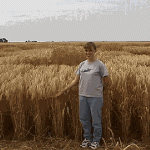 Slide 8. Triticale, the world’s first man-made cereal, may be a grazing and grain alternative for area farmers and ranchers. It’s massive root system enables it to withstand drought and it produces excellent winter grazing. It’s grain has feed value as good or better than wheat.
Slide 8. Triticale, the world’s first man-made cereal, may be a grazing and grain alternative for area farmers and ranchers. It’s massive root system enables it to withstand drought and it produces excellent winter grazing. It’s grain has feed value as good or better than wheat.
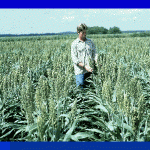 Slide 9. Sorghum is not a new crop to the Rolling Plains. In fact, the home of hybrid grain sorghum is the Texas AgriLife Research Station at Chillicothe. Nevertheless, grain sorghum may increase in importance in the Rolling Plains as a component of integrated crop management systems as new production strategies, new markets and adapted genotypes are discovered. The Sorghum Conversion Program, a process of genetically converting tall, late-maturing tropical sorghums to temperate types which can be successfully grown in Texas, is accomplished by AgriLife Research scientists at Chillicothe in cooperation with sorghum researchers at Lubbock and College Station.
Slide 9. Sorghum is not a new crop to the Rolling Plains. In fact, the home of hybrid grain sorghum is the Texas AgriLife Research Station at Chillicothe. Nevertheless, grain sorghum may increase in importance in the Rolling Plains as a component of integrated crop management systems as new production strategies, new markets and adapted genotypes are discovered. The Sorghum Conversion Program, a process of genetically converting tall, late-maturing tropical sorghums to temperate types which can be successfully grown in Texas, is accomplished by AgriLife Research scientists at Chillicothe in cooperation with sorghum researchers at Lubbock and College Station.
 Slide 10. The establishment of a new 2 million hen chicken egg-laying facility near Vernon will provide new markets for these grain crops as well as others including millets.
Slide 10. The establishment of a new 2 million hen chicken egg-laying facility near Vernon will provide new markets for these grain crops as well as others including millets.
 Slide 11. We also are learning new ways to increase value of the region’s two main crops: wheat and cotton. The only wheat breeding program in the United States which focuses on the development of forage wheats exists at Vernon.
Slide 11. We also are learning new ways to increase value of the region’s two main crops: wheat and cotton. The only wheat breeding program in the United States which focuses on the development of forage wheats exists at Vernon.
 Slide 12. Lockett, a wheat developed primarily for grazing was released in 1998 and may help bridge the forage gap between the traditional wheat grazing season ending in early May and the onset of grazing warm season pastures in June. We know that we can successfully produce each of these crops in the Rolling Plains. We want to learn to do so in a manner that is not only profitable but also environmentally beneficial.
Slide 12. Lockett, a wheat developed primarily for grazing was released in 1998 and may help bridge the forage gap between the traditional wheat grazing season ending in early May and the onset of grazing warm season pastures in June. We know that we can successfully produce each of these crops in the Rolling Plains. We want to learn to do so in a manner that is not only profitable but also environmentally beneficial.
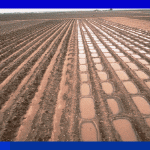 Slide 13. Anyone who regularly travels the Rolling Plains is aware of the dust storms which frequent our region and the red color of our surface water. We have to find better ways to preserve the rich soil resources upon which our industry depends. Center scientists are investigating new techniques that will add to our crop diversity while concurrently decreasing soil erosion due to wind and water. Canola, wheat, and mixtures of canola and wheat are being planted in strips within cotton fields. These strips are planted in the fall prior to cotton harvest, in rows perpendicular to prevailing winds and, by the time the cotton is removed, have developed a vegetative cover sufficient to alter wind and water velocities thereby decreasing erosion.
Slide 13. Anyone who regularly travels the Rolling Plains is aware of the dust storms which frequent our region and the red color of our surface water. We have to find better ways to preserve the rich soil resources upon which our industry depends. Center scientists are investigating new techniques that will add to our crop diversity while concurrently decreasing soil erosion due to wind and water. Canola, wheat, and mixtures of canola and wheat are being planted in strips within cotton fields. These strips are planted in the fall prior to cotton harvest, in rows perpendicular to prevailing winds and, by the time the cotton is removed, have developed a vegetative cover sufficient to alter wind and water velocities thereby decreasing erosion.
 Slide 14. These “green bridges” offer the added benefit of serving as a reservoir for beneficial insects, i.e. those utilized to combat insect pests in subsequent corps.
Slide 14. These “green bridges” offer the added benefit of serving as a reservoir for beneficial insects, i.e. those utilized to combat insect pests in subsequent corps.
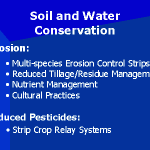 Slide 15. Research continues on crop management systems which require less mechanical disturbance of soil and allow greater amounts of vegetative residue to remain on the soil surface. We cannot directly import the zero tillage work practiced in the corn fields of Iowa, but through research, we can develop our own reduced input practices adapted to our climate and our cropping systems. Crucial to the success of these less input intensive crop management systems is scientifically based information on critical nutrient needs and proper planting times. We know that much of our irrigation water is relatively high in nitrogen. What we don’t know, but currently are investigating is how much inorganic nitrogen fertilizer can be saved in irrigated systems simply by accounting for the nitrogen contained in the applied water. Another aspect of environmental stewardship/soil and water conservation is the decreased utilization of insecticides. Strip crop relay systems have been developed which enhance biological control of cotton insect pests by providing safe harbors for the beneficial insects which prey on the insects which feed on cotton. The entomology program at Vernon has expanded the EPA directive to limit the use of harsh insecticides into an integrated approach involving multiple insect pests, diverse plant species, beneficial insects and cultural control.
Slide 15. Research continues on crop management systems which require less mechanical disturbance of soil and allow greater amounts of vegetative residue to remain on the soil surface. We cannot directly import the zero tillage work practiced in the corn fields of Iowa, but through research, we can develop our own reduced input practices adapted to our climate and our cropping systems. Crucial to the success of these less input intensive crop management systems is scientifically based information on critical nutrient needs and proper planting times. We know that much of our irrigation water is relatively high in nitrogen. What we don’t know, but currently are investigating is how much inorganic nitrogen fertilizer can be saved in irrigated systems simply by accounting for the nitrogen contained in the applied water. Another aspect of environmental stewardship/soil and water conservation is the decreased utilization of insecticides. Strip crop relay systems have been developed which enhance biological control of cotton insect pests by providing safe harbors for the beneficial insects which prey on the insects which feed on cotton. The entomology program at Vernon has expanded the EPA directive to limit the use of harsh insecticides into an integrated approach involving multiple insect pests, diverse plant species, beneficial insects and cultural control.
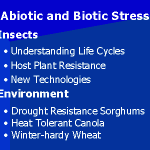 Slide 16. Abiotic and biotic stresses are major limiting factors to crop production in the Rolling Plains. We’ve briefly discussed some of the work currently underway relative to insect pests. Additional entomological research investigates the life cycles of pest insects. A complete understanding of basic life cycles may serve to identify weak links which can be exploited in integrated pest management systems in which chemical control plays an ever decreasing role. Host plant resistance to insects and diseases is the most cost effective method of control and area in which Center scientists have been involved for many years. Multiple pest resistant cottons adapted to the Rolling Plains have been developed in cooperative studies with scientists at College Station. Wheats resistant to damaging disease and insect pests have been developed and released by the Vernon Center. The new legislative initiative known as TxGrain is enabling scientists at the Vernon Center to access new methods developed through biotechnology to control disease, insect and weed pests of grain crops in the Rolling Plains. The TexCot program, another legislative initiative, continues to provide important resources for investigations on cotton pest control. Research at Chillicothe and Munday includes studies of the potential role that bioengineered crops such at Bt cotton and Roundup Ready cotton and soybean may have on Rolling Plains production.Abiotic stresses include drought, high spring and summer temperatures and cold temperatures in the winter. Collaborative research programs at Vernon have been developed to combat these environmental stresses. Chillicothe serves as one of the main screening locations in the United States for identification of drought resistant sorghum genotypes. Success of canola in the Rolling Plains will largely depend on the identification and development of new winter hardy varieties that resist the seed shattering caused by high temperatures and low humidity at harvest. Wheat and other small grains that continue to grow during cold winter months but resist the damage caused by low temperatures are being developed. More water-efficient crops are being identified as are more efficient integrated crop management systems.
Slide 16. Abiotic and biotic stresses are major limiting factors to crop production in the Rolling Plains. We’ve briefly discussed some of the work currently underway relative to insect pests. Additional entomological research investigates the life cycles of pest insects. A complete understanding of basic life cycles may serve to identify weak links which can be exploited in integrated pest management systems in which chemical control plays an ever decreasing role. Host plant resistance to insects and diseases is the most cost effective method of control and area in which Center scientists have been involved for many years. Multiple pest resistant cottons adapted to the Rolling Plains have been developed in cooperative studies with scientists at College Station. Wheats resistant to damaging disease and insect pests have been developed and released by the Vernon Center. The new legislative initiative known as TxGrain is enabling scientists at the Vernon Center to access new methods developed through biotechnology to control disease, insect and weed pests of grain crops in the Rolling Plains. The TexCot program, another legislative initiative, continues to provide important resources for investigations on cotton pest control. Research at Chillicothe and Munday includes studies of the potential role that bioengineered crops such at Bt cotton and Roundup Ready cotton and soybean may have on Rolling Plains production.Abiotic stresses include drought, high spring and summer temperatures and cold temperatures in the winter. Collaborative research programs at Vernon have been developed to combat these environmental stresses. Chillicothe serves as one of the main screening locations in the United States for identification of drought resistant sorghum genotypes. Success of canola in the Rolling Plains will largely depend on the identification and development of new winter hardy varieties that resist the seed shattering caused by high temperatures and low humidity at harvest. Wheat and other small grains that continue to grow during cold winter months but resist the damage caused by low temperatures are being developed. More water-efficient crops are being identified as are more efficient integrated crop management systems.
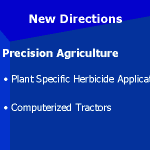 Slide 17. AgriLife Research and Extension Scientists are heavily involved in research and education programs which explore new ways to facilitate a safer, more productive and profitable flow of agricultural products to the consuming public. For example, precision application of agricultural inputs is being studied.
Slide 17. AgriLife Research and Extension Scientists are heavily involved in research and education programs which explore new ways to facilitate a safer, more productive and profitable flow of agricultural products to the consuming public. For example, precision application of agricultural inputs is being studied.
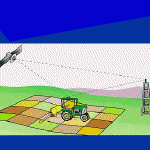 Slide 18. These new technologies could dramatically decrease the amount of chemical use through image-activated targeting of weeds. Hooded sprayers equipped with electronic eyes can detect weeds and only apply herbicide to the targeted weed, thus negating the need to spray chemical over the entire field.
Slide 18. These new technologies could dramatically decrease the amount of chemical use through image-activated targeting of weeds. Hooded sprayers equipped with electronic eyes can detect weeds and only apply herbicide to the targeted weed, thus negating the need to spray chemical over the entire field.
 Slide 19 Also, computerized tractor monitoring systems have been developed at Vernon which greatly decrease fuel consumption by matching tractor output with proper implement pulling requirements.
Slide 19 Also, computerized tractor monitoring systems have been developed at Vernon which greatly decrease fuel consumption by matching tractor output with proper implement pulling requirements.
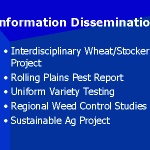 Slide 20.This research would be a poor public investment if there was no way to facilitate its adoption. Adoption in the Rolling Plains is accomplished through collaborative efforts of research and extension services. Examples of these hands-on programs include the Interdisciplinary Wheat/Stocker Cattle program in Wichita County, insect monitoring projects in all field crops, the uniform variety testing nurseries with wheat, peanuts, cotton and grain sorghum, weed control trials placed with farmer cooperators throughout the region and the integrated wheat/cool season-warm season grazing project funded through the Southern Region Sustainable Agriculture Program and located on the David Kearney Farm near Iowa Park.
Slide 20.This research would be a poor public investment if there was no way to facilitate its adoption. Adoption in the Rolling Plains is accomplished through collaborative efforts of research and extension services. Examples of these hands-on programs include the Interdisciplinary Wheat/Stocker Cattle program in Wichita County, insect monitoring projects in all field crops, the uniform variety testing nurseries with wheat, peanuts, cotton and grain sorghum, weed control trials placed with farmer cooperators throughout the region and the integrated wheat/cool season-warm season grazing project funded through the Southern Region Sustainable Agriculture Program and located on the David Kearney Farm near Iowa Park.
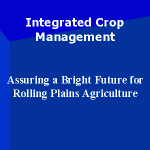 Slide 21. Scientists are conducting agricultural research and extension programs in the area of Texas with the highest agricultural risk and the lowest profit margin. We are most concerned with cost-effective ways to continue to produce agricultural products. Our focus is integrated crop management that includes precision agriculture, plant breeding, entomology, plant pathology, weed science, agronomy, animal science and economics. New developments in these systems by Research Station scientists and efficient dissemination of research-based information through the AgriLife Extension Service assure a bright future for the Rolling Plains agriculture.
Slide 21. Scientists are conducting agricultural research and extension programs in the area of Texas with the highest agricultural risk and the lowest profit margin. We are most concerned with cost-effective ways to continue to produce agricultural products. Our focus is integrated crop management that includes precision agriculture, plant breeding, entomology, plant pathology, weed science, agronomy, animal science and economics. New developments in these systems by Research Station scientists and efficient dissemination of research-based information through the AgriLife Extension Service assure a bright future for the Rolling Plains agriculture.